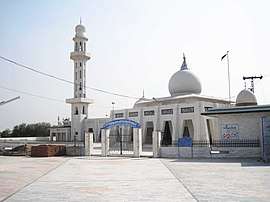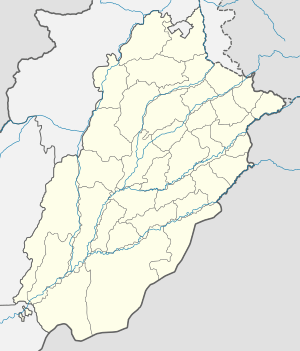Gujrat, Pakistan
Gujrat (Punjabi, Urdu: گُجرات), is a city in the Punjab Province of Pakistan.[3] It is the capital of Gujrat District and it is the 20th largest city of Pakistan by population.[4][2] Along with the nearby cities of Sialkot and Gujranwala, Gujrat forms part of the so-called Golden Triangle of industrial cities with export-oriented economies.[5][6]
Gujrat گُجرات | |
|---|---|
   | |
 Gujrat | |
| Coordinates: 32°34′26″N 74°4′44″E | |
| Country | |
| Province | |
| Division | Gujranwala |
| District | Gujrat |
| Government | |
| • Deputy Commissioner | Dr. Khurram Shehzad |
| • District Police Officer | Tauseef Haider |
| Area | |
| • Total | 65 km2 (25 sq mi) |
| Population | |
| • Total | 390,533 |
| • Rank | 20th, Pakistan |
| • Density | 6,000/km2 (16,000/sq mi) |
| Time zone | UTC+5 (PST) |
| Calling code | 053 |
| Number of Union councils | 18[2] |
History
The area around Gujrat was settled during the reign of the Suri ruler Sher Shah prior the Mughals.[7] The area was named Khwaspur,[7] in honour of Suri's Governor of Rohtas, Khwas Khan. Local traditions state that Gujrat is the second town to be built in the area, with the first having been destroyed by Mongol invasions in 1303.[8]
The city came under the Mughal Empire and was further developed during the reign of the Mughal Emperor Akbar, who built the Gujrat Fort in 1580,[9] and compelled local Gujjars to settle in the city in 1596–97.[7][10] The city was then named in reference to the Gujjar tribes.[7] In 1605, Syed Abdul Kasim was granted the city as a fief by Akbar.[7]
During the reign of Emperor Jahangir, Gujrat was part of the route used by Mughal royals when visiting Kashmir.[11]
Legend has it that the most famous saint of Gujrat, Shah Daula, is credited with having saved the city from the Sikh Guru Hargobind when the people of Gujrat made fun out of him during his stay as he was returning from Kashmir around 1620.[10]
During the Mughal era, Gujrat was encircled by a wall with 5 gates, of which only the Shah Daula gate survives.[12]

With the death of Aurangzeb in 1707, the Mughal Empire began to weaken significantly. However the authority which did linger on remained in the hands of Mughal Nawabs who gave nominal allegiance to the Mughal emperor in Delhi. However in 1739, the powerful Turko-Iranian ruler Nader Shah gave the Mughals the final blow when he launched a plundering invasion sacking their capital Delhi.[7] During his campaign, Nadir Shah sacked Gujrat on the way which was at the time a prosperous city. Shortly afterwards around 1741, the city was captured by local Punjabi Gakhar tribesmen in the ensuing chaos from near the Rawalpindi area.[8] The city suffered further from the eight invasions of the Durrani Afghans under their new energetic ruler Ahmad Shah Durrani between 1748 and 1767.[7]
In 1765, the city was overrun by the Sikh Bhangi Misl under Gujjar Singh who defeated the Punjabi Ghakars under Muqqarab Khan.[8] The Sikhs defeated an Afghan force in a battle for Gujrat on 29 April 1797.[13] In 1798, the Bhangi leader Sahib Singh pledged allegiance to the Sukerchakia Misl of Ranjit Singh who later established the Sikh Empire in 1799.[7] By 1810, Ranjit Singh's armies captured the city from Bhangi forces, thereby extending the rule of the Sikh Empire to the city.[7]
Gujrat finally came under British control in 1849, following the collapse of the Sikh Empire in the wake of the Sikh defeat at the Battle of Gujrat on 22 February, which ended the Second Anglo-Sikh War.[7] In 1867, Gujrat was constituted as a municipality.[9]
Geography
Gujrat is an ancient city of Pakistan located between two famous rivers, Jhelum River and Chenab River. It is bounded to the northeast by Jammu and Kashmir, to the northwest by the Jhelum River, to the east and southeast by the Chenab River, separating it from the districts of Gujranwala and Sialkot; and to the west by Mandi Bahauddin District. Gujrat consists of three Tehsils which are Sarai Alamgir, Kharian and Gujrat.
Notable politicians
- Aitzaz Ahsan, Pakistani barrister
- Chaudhry Hussain Elahi, Member of the National Assembly of Pakistan. He is the son of Chaudhry Wajahat Hussain.
- Chaudhry Pervaiz Elahi, former Deputy Prime Minister of Pakistan, former Chief Minister of Punjab, Speaker of the Provincial Assembly of Punjab from 16 August 2018 to date, previously from 1997 to 1999. Former Chairman District Council, Gujrat, and former Provincial Minister for Local Government and Rural Development.
- Chaudhry Zahoor Elahi, (Shaheed). Member of the National Assembly of Pakistan in 1962 & 1970. Deputy Opposition Leader in the National Assembly of Pakistan from 1972 to 1977.Federal Minister for Manpower, Labor, Local Government & Rural Development from 1978 to 1979.
- Moonis Elahi, Member of the National Assembly of Pakistan, twice elected as the member of the Provincial Assembly of Punjab from 2008 to 2013 & 2013 to 2018.
- Nawabzada Ghazanfar Ali Gul, former Federal Minister of Pakistan
- Chaudhry Shujaat Hussain, former Prime Minister of Pakistan, Member Pakistan Majlis-e-Shura. Re-elected 5 times as the Member of the National Assembly of Pakistan. Re-elected twice as the Member of the Senate of Pakistan. Former Federal Minister for Interior, Information, Industries & Production. "Honorary Consul General" of the Republic of Korea.
- Chaudhry Wajahat Hussain, former Federal Minister for Overseas Pakistanis, Federal Minister for Labour and Manpower and Federal Minister for Human Resource Development.3 times MPA and 2 times MNA.
- Saleem Sarwar Jaura, member Provincial Assembly of Punjab
- Mian Imran Masood, former MPA of Gujrat and Minister of Education Punjab.
- Ahmad Mukhtar, former Minister for Defence Government of Pakistan
- Shujaat Nawaz, Member of the Provincial Assembly of Punjab
- Yasmin Qureshi, British MP
- Muhammad Abdullah Warraich, Member of the Provincial Assembly of Punjab
Climate
Gujrat has a hot semi-arid climate (Köppen climate classification BSh).
| Climate data for Gujrat | |||||||||||||
|---|---|---|---|---|---|---|---|---|---|---|---|---|---|
| Month | Jan | Feb | Mar | Apr | May | Jun | Jul | Aug | Sep | Oct | Nov | Dec | Year |
| Average high °C (°F) | 19.2 (66.6) |
22.1 (71.8) |
27.4 (81.3) |
33.7 (92.7) |
39.1 (102.4) |
41.1 (106.0) |
36.3 (97.3) |
34.6 (94.3) |
35.1 (95.2) |
33.1 (91.6) |
27.2 (81.0) |
21.2 (70.2) |
30.8 (87.5) |
| Daily mean °C (°F) | 12.4 (54.3) |
15.1 (59.2) |
20.3 (68.5) |
26 (79) |
31.1 (88.0) |
34 (93) |
31.4 (88.5) |
30.2 (86.4) |
29.4 (84.9) |
25.3 (77.5) |
18.7 (65.7) |
13.5 (56.3) |
24.0 (75.1) |
| Average low °C (°F) | 5.6 (42.1) |
8.1 (46.6) |
13.3 (55.9) |
18.4 (65.1) |
23.2 (73.8) |
26.9 (80.4) |
26.6 (79.9) |
25.8 (78.4) |
23.8 (74.8) |
17.6 (63.7) |
10.2 (50.4) |
5.8 (42.4) |
17.1 (62.8) |
| Average precipitation mm (inches) | 38 (1.5) |
37 (1.5) |
36 (1.4) |
21 (0.8) |
19 (0.7) |
47 (1.9) |
182 (7.2) |
205 (8.1) |
83 (3.3) |
12 (0.5) |
5 (0.2) |
18 (0.7) |
703 (27.8) |
| Source: https://en.climate-data.org/location/964104/ | |||||||||||||
Education


Some of the notable educational institutes of Gujrat include:
- University of Gujrat[14]
- Nawaz Sharif Medical College[15]
- Punjab College of Science, Gujrat Campus[16]
- The Superior College, Gujrat Campus[17]
- Beaconhouse School System[18]
- The Educators[19]
- Lahore Grammar School[20]
- Dar-e-Arqam Schools[21]
Twin towns and sister cities

References
- "PAKISTAN: Provinces and Major Cities". PAKISTAN: Provinces and Major Cities. citypopulation.de. Retrieved 4 May 2020.
- "Tehsils & Unions in the District of Gujrat – Government of Pakistan". Archived from the original on 14 February 2009.
- Google maps. "Location of Gujrat". Google maps. Retrieved 23 September 2013.
- "Pakistan City & Town Population List". Tageo.com website. Retrieved 29 September 2017.
- Mehmood, Mirza, Faisal; Ali, Jaffri, Atif; Saim, Hashmi, Muhammad (21 April 2014). An assessment of industrial employment skill gaps among university graduates: In the Gujrat-Sialkot-Gujranwala industrial cluster, Pakistan. Intl Food Policy Res Inst. p. 2.
- Naz, Neelum. "Historical Perspective of Urban Development of Gujranwala". Dept. of Architecture, UET, Lahore. Retrieved 22 December 2017.
- "Imperial Gazetteer2 of India, Volume 12, page 365 -- Imperial Gazetteer of India -- Digital South Asia Library". dsal.uchicago.edu. Retrieved 2 February 2018.
- Americanized Encyclopaedia Britannica: Rev. and Amended A Dictionary of Arts, Sciences and Literature, to which is Added Biographies of Living Subjects. 96 Colored Maps and Numerous Illustrations. Belford-Clarke Company. 1890.
- "Gujrat | Pakistan". Encyclopedia Britannica. Retrieved 2 February 2018.
- Malhotra, Anshu; Mir, Farina (21 February 2012). Punjab Reconsidered: History, Culture, and Practice. Oxford University Press. ISBN 9780199088775.
- Bhat, Muzaffar (22 September 2017). "The Mughal road to Srinagar". The Friday Times. Retrieved 2 February 2018.
- "Last vestige of Mughal era in Gujrat | ePaper | DAWN.COM". epaper.dawn.com. Retrieved 2 February 2018.
- Jaques, Tony (2007). Dictionary of Battles and Sieges: F-O. Greenwood Publishing Group. ISBN 9780313335389.
- "You are being redirected..." uog.edu.pk.
- "You are being redirected..." uog.edu.pk.
- "Punjab Group of Colleges | The Largest Educational Network in Pakistan - Punjab Group of Colleges".
- "SUPERIOR COLLEGE GUJRAT | Superior Group Of Colleges".
- "Home". Beaconhouse.
- "The Educators - A Project of Beaconhouse". www.educators.edu.pk.
- "LAHORE GRAMMAR SCHOOL | Prepared to Lead".
- "Dar-e-Arqam Schools Gujrat Region | Best School in Pakistan". darearqam.edu.pk.